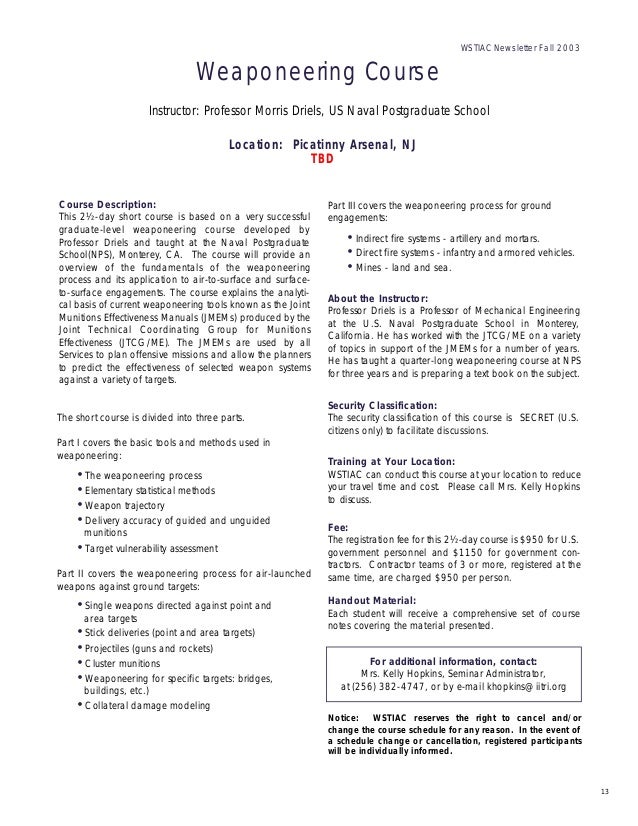Joint Munitions Effectiveness Manual
. JTCG/ME PO JTCG/ME PO Joint Technical Coordinating Group for Munitions Effectiveness Program Office Mission Providing nonnuclear munitions effectiveness information for operational commanders, weapon system designers, logisticians, and DoD targeteers and planners. Focus The Joint Technical Coordinating Group for Munitions Effectiveness (JTCG/ME) was established in 1964. Since its inception, the JTCG/ME's primary objective has been to provide Soldiers, Operational Commanders, DoD targeteers, weaponeers, planners, weapon system designers, and logisticians with the latest, most accurate non-nuclear weapons effectiveness data in an easy-to-use format. This tri-service approved data is currently available in the Joint Munitions Effectiveness Manuals (JMEMs) produced by the JTCG/ME on CD-ROMs and in Special Reports. The information includes damage/kill probabilities for specific weapons and targets, physical and functional characteristics of munitions and weapon systems, target vulnerability, obscuration on weapon effectiveness, and analytical techniques and procedures for assessing munitions effectiveness. This ensures that Commanders, Soldiers, planners, and logisticians are using the most effective munitions to support Operational Plans (OPLANs).
The proper application of combined air-to-surface, surface-to-surface, anti-air, and special forces against specific targets is a decisive factor in the success of any military operation. Selection of optimum weaponry in conjunction with appropriate tactics will ensure efficient destruction of the target with minimum exposure of friendly personnel.
JMEMs were used in planning strikes during the Vietnam War, operations in Libya, Lebanon, the Persian Gulf, Panama, Desert Storm, Operation Southern Watch, Bosnia, Kosovo, and are currently being used in Operation Enduring Freedom, Operation Iraqi Freedom, and other current operations. JMEM data are also widely used for training targeteers and weaponeers at service schools, conducting exercises, and supporting deployment Contingency Planning (CONPLANs). The rapid evolution of smart and brilliant munitions sharpens the need for new and better analysis techniques and more accurate data to support the Soldier in the weaponeering process. The JTCG/ME is ensuring that the Soldier is well equipped with the latest munitions effectiveness data today and in the future.
The JTCG/ME is also responsible for managing AMSAA's Joint Data Center (JDC). The primary functions of the JDC are:. Provide a single source for AMSAA item level weapons characteristics and performance data to respond to data requests for Army and DoD studies. Implement AMSAA internal policy on item level performance (weapons effectiveness) data request process (data request reception, generation, certification, and transmission) with the intent of introducing efficiencies in the overall process to allow Divisions analysts/SME's to focus on methodology enhancements and non-routine data generation.
Implement and market the end-state vision to provide seamless connectivity between data producers & consumers via latest Information Technology (Internet, Database, etc.). Define and implement continuous process improvements. Establish standards for operations consistent with DoD/Army/industry standards. Establish Army conduit for joint weapons systems performance and characteristics data requirements to support Army studies and analysis related to developmental systems.
Description: The American Intelligence Journal is the flagship publication of the NMIA. Now in its fourth decade, the Journal's focus remains on education and professional development.
We seek to augment both the capabilities and the performance of armed forces intelligence operators and their civilian counterparts. The legal environment increasingly demands joint, interagency, and coalition approaches to military and homeland security operations.
Today, the military intelligence professional must be proficient across traditional and emerging disciplines, missions, and functions. NMIA is the only joint military intelligence professional association in the United States. Our American Intelligence Journal offers readers an artful balance between the wisdom of scholars and the street smarts of practitioners. The 'moving wall' represents the time period between the last issue available in JSTOR and the most recently published issue of a journal. Moving walls are generally represented in years. In rare instances, a publisher has elected to have a 'zero' moving wall, so their current issues are available in JSTOR shortly after publication.
Joint Munitions Effectiveness Manual Weaponeering System
Note: In calculating the moving wall, the current year is not counted. For example, if the current year is 2008 and a journal has a 5 year moving wall, articles from the year 2002 are available. Terms Related to the Moving Wall Fixed walls: Journals with no new volumes being added to the archive. Absorbed: Journals that are combined with another title. Complete: Journals that are no longer published or that have been combined with another title. ABSTRACT This article summarizes a 10-year effort to develop cyber planning tools equivalent to conventional or nuclear weapons planning models and data. Cyber operations require more detailed data because of the precise technical nature of these activities.
Cyber Joint Munitions Effectiveness Manual

However, security classifications, which are due to an adversary’s ability easily to remove vulnerabilities and to reveal intelligence sources, make obtaining effectiveness data difficult. While some argue that similar planning data are not appropriate for cyber, we contend that, as for conventional weapons, some situations require planning effectiveness calculations. We conclude by proposing a scheme where highly classified and precise tests are conducted; however, only aggregate data that do not reveal how the cyber effect is achieved could be provided to operational planners.